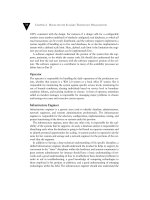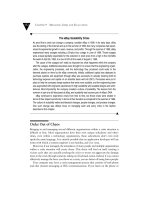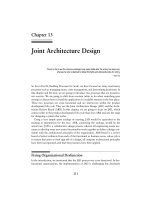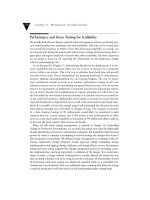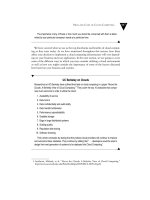IT training WP OReilly media augmented reality for the industrial enterprise a hands on introduction to rapid ar development khotailieu
Bạn đang xem bản rút gọn của tài liệu. Xem và tải ngay bản đầy đủ của tài liệu tại đây (3.51 MB, 80 trang )
Co
m
pl
im
en
Leah Hunter
of
A Hands-On Introduction to
Rapid AR Development
ts
Augmented Reality
for the Industrial
Enterprise
ThingWorx Studio
Create Augmented Reality Experiences
for the Industrial Enterprise.
Using ThingWorx Studio, it is easier than ever for content creators to deliver
purpose-built AR experiences for smart, connected products in the industrial
enterprise using a drag-and-drop authoring environment and eliminating the need
to write AR code.
ThingWorx Studio is scalable and delivers unmatched high-quality AR
experiences. By harnessing the power of AR for the industrial enterprise, you can:
Accelerate Product Adoption
Reduce Service and Maintenance Costs
Enhance Customer Loyalty and Satisfaction
Sign up for your free ThingWorx Studio trial by visiting Thingworx.com/go/ar
Augmented Reality for the
Industrial Enterprise
A Hands-On Introduction to
Rapid AR Development
Leah Hunter
Beijing
Boston Farnham Sebastopol
Tokyo
Augmented Reality for the Industrial Enterprise
by Leah Hunter
Copyright © 2017 O’Reilly Media, Inc. All rights reserved.
Printed in the United States of America.
Published by O’Reilly Media, Inc., 1005 Gravenstein Highway North, Sebastopol, CA
95472.
O’Reilly books may be purchased for educational, business, or sales promotional use.
Online editions are also available for most titles ( For more
information, contact our corporate/institutional sales department: 800-998-9938 or
Editor: Susan Conant
Production Editor: Colleen Cole
Copyeditor: Rachel Monaghan
May 2017:
Interior Designer: David Futato
Cover Designer: Karen Montgomery
Illustrator: Rebecca Demarest
First Edition
Revision History for the First Edition
2017-05-11: First Release
The O’Reilly logo is a registered trademark of O’Reilly Media, Inc. Augmented Real‐
ity for the Industrial Enterprise, the cover image, and related trade dress are trade‐
marks of O’Reilly Media, Inc.
While the publisher and the author have used good faith efforts to ensure that the
information and instructions contained in this work are accurate, the publisher and
the author disclaim all responsibility for errors or omissions, including without limi‐
tation responsibility for damages resulting from the use of or reliance on this work.
Use of the information and instructions contained in this work is at your own risk. If
any code samples or other technology this work contains or describes is subject to
open source licenses or the intellectual property rights of others, it is your responsi‐
bility to ensure that your use thereof complies with such licenses and/or rights.
978-1-491-96804-8
[LSI]
Table of Contents
Preface. . . . . . . . . . . . . . . . . . . . . . . . . . . . . . . . . . . . . . . . . . . . . . . . . . . . . . . . v
1. Why AR and Why Now?. . . . . . . . . . . . . . . . . . . . . . . . . . . . . . . . . . . . . . . 1
Pokémon GO Was a Fad—And Also a Tipping Point
Industrial Enterprise AR: The Inflection Point
You Should Get Really Clear Up Front: This Is Not VR
Why Now Is the Best Time to Develop AR
AR Has Reached the Usability Phase
Where AR and IoT Connect
Workforce Transformation: AR for Knowledge Transfer
(Industries Are Blending)
Cross-Domain Technical Skills
What Is the Business Justification for This (AKA Show Me
the Numbers)?
What Else Should You Know?
2
3
3
5
7
8
9
10
11
12
2. AR Creators and Use Cases You Should Know. . . . . . . . . . . . . . . . . . . . 13
AR Can Save You Money
AR Can Help Humans
AR Can Be Used by Big and Small Companies and
Communities
Big and Small Companies Are Creating AR Strategies Now
14
17
20
22
3. Key Technologies for Building AR Experiences (and Why They Matter)
. . . . . . . . . . . . . . . . . . . . . . . . . . . . . . . . . . . . . . . . . . . . . . . . . . . . . . . . . . 27
AR Content Creation: It’s a Challenge—And There Are
Tools That Can Help
29
iii
ThingWorx Studio: Blue Pump Tutorial
Authoring: “What Else You Should Know” Deeper Dive
Why You Should Also Know About SLAM
31
48
50
4. Your Best Strategy for AR Growth. . . . . . . . . . . . . . . . . . . . . . . . . . . . . 53
AR for Enterprise: What Else Is Happening
Enterprise AR in Real Estate, Education, and Retail: What
You Should Know (and Question)
How Can You Cash In Financially and Ethically from AR
Over the Next Five Years?
53
55
57
A. The Future of AR. . . . . . . . . . . . . . . . . . . . . . . . . . . . . . . . . . . . . . . . . . . . 61
iv
|
Table of Contents
Preface
Industrial augmented reality can make a meaningful difference for
workers.
The difference between where it is now and where it will be in 10
years is huge. What can industrial-use augmented reality (AR) do
right now? It can help building contractors “see” into walls and
know where to lay wiring. How about that AR in 10 years? It could
enable the whole crew to walk into a holographic building and virtu‐
ally lay out wiring, plumbing, lighting, and Wi-Fi systems in real
time, checking for problems even before they build.
The first scenario is already in the works. The second is coming
faster than you may imagine, and this book can help you get started
with your own AR development.
But first, let’s look at the differences between augmented reality and
virtual reality (VR).
Augmented or Virtual: Depends On What You
Want to Do
In theory, the distinctions between virtual and augmented reality are
clear. Virtual reality takes you into the digital world. Augmented
reality pulls the digital world into your reality—it weaves digital
images onto and into everything.
In practice, it isn’t that simple, and it would take more than a few
sentences to explain. Helen Papagiannis, an expert with a PhD in
augmented reality, succinctly sums up her view of the differences
between AR and VR in “Designing Beyond Screens to Augment the
v
Full Human Sensorium,” if you’d like to read more. For our purposes
here, it suffices to say that the new breed of AR systems still relies on
VR headsets—like the Oculus—and many of the people who play in
one space play in both.
While a lot of virtual reality growth is coming from gaming, AR is
starting with business. The reason makes a lot of sense: for AR to
work well in business, you need a use case with clearly defined
requirements.
Todd Harple, Intel experience engineer/innovation lead in Intel’s
New Devices Group—and the man who led several of the company’s
VR and AR research projects—explains:
Over the last year or two, AR has taken a turn toward the business
side of things. That’s because it takes a tight vertical to make it work
effectively. We purchased Recon last year, and a lot of their use
cases are tight verticals. Recon Jet was about cycling—that enables
you to build the device with only what is necessary for cycling. And
it gives you a clear understanding of the physical and linguistic
vocabulary, as opposed to “I have a telephone that can do every‐
thing on my eyes.” Field service and equipment inspection are simi‐
lar. You can [program the system to] have a clear understanding of
what is in the walls because there’s a CAD drawing somewhere.
Which is to say: you can’t program a hologram to work well in a
space unless you understand what is in that space, what people do
there, and how it all works together.
For instance, computer vision systems are currently great at under‐
standing that a sofa is rectangular. But they are not great at under‐
standing that the sofa is covered with a material that should squish
down when someone sits on it. And in the case of enterprise, you
can only create an AR system for picking items in a warehouse when
you understand exactly what is in that warehouse, how it is organ‐
ized, and what is there at any given time.
“The promise of the new breed of AR systems is that they can place
content into a world in the way that it seems like it’s natural to that
world,” says perceptual neuroscientist Beau Cronin. “From my point
of view, the more interesting challenge is that if you are going to put
that content out into the world, you need to understand the world
you’re putting it into.”
vi
|
Preface
How This Book Is Organized
How can AR help your business? And more importantly, how can
augmented reality help you?
This short book gives you answers to those questions, via a handson introduction to industrial AR development. It is organized as fol‐
lows:
Chapter 1, Why AR and Why Now?
Explores why now is the right time for industrial AR.
Chapter 2, AR Creators and Use Cases You Should Know
Outlines how people are using AR to save time and money, via a
few enterprise case studies.
Chapter 3, Key Technologies for Building AR Experiences (And Why
They Matter)
Gives you the opportunity to create a simple AR project with a
tutorial, using ThingWorx Studio—your chance to test the tech‐
nology.
Chapter 4, Your Best Strategy for AR Growth
Brings it all together, with guidance to help you shape your own
strategy for industrial enterprise AR
Appendix A, The Future of AR
Looks even further into the future of augmented reality technol‐
ogy. Because if you’re like me, you’re curious about what’s com‐
ing—and what you should be paying attention to as the category
evolves.
Let’s start at the beginning.
Conventions Used in This Book
The following typographical conventions are used in this book:
Italic
Indicates new terms, URLs, email addresses, filenames, and file
extensions.
Constant width
Used for program listings, as well as within paragraphs to refer
to program elements such as variable or function names, data‐
Preface
|
vii
bases, data types, environment variables, statements, and key‐
words.
Constant width bold
Shows commands or other text that should be typed literally by
the user.
O’Reilly Safari
Safari (formerly Safari Books Online) is a
membership-based training and reference
platform for enterprise, government, educa‐
tors, and individuals.
Members have access to thousands of books, training videos, Learn‐
ing Paths, interactive tutorials, and curated playlists from over 250
publishers, including O’Reilly Media, Harvard Business Review,
Prentice Hall Professional, Addison-Wesley Professional, Microsoft
Press, Sams, Que, Peachpit Press, Adobe, Focal Press, Cisco Press,
John Wiley & Sons, Syngress, Morgan Kaufmann, IBM Redbooks,
Packt, Adobe Press, FT Press, Apress, Manning, New Riders,
McGraw-Hill, Jones & Bartlett, and Course Technology, among oth‐
ers.
For more information, please visit />
How to Contact Us
Please address comments and questions concerning this book to the
publisher:
O’Reilly Media, Inc.
1005 Gravenstein Highway North
Sebastopol, CA 95472
800-998-9938 (in the United States or Canada)
707-829-0515 (international or local)
707-829-0104 (fax)
To comment or ask technical questions about this book, send email
to
viii
|
Preface
For more information about our books, courses, conferences, and
news, see our website at .
Find us on Facebook: />Follow us on Twitter: />Watch us on YouTube: />
Preface
|
ix
CHAPTER 1
Why AR and Why Now?
Augmented reality (AR) is not new, but its evolution is entering a
new phase—which I think of as “finally usable by a broad group of
people.”
We’ve passed the “trough of disillusionment” that comes with any
new technology. Big-name companies are investing heavily in the
space, as are individual investors. The hardware that drives the tech‐
nology has made leaps, particularly in the past year and a half. And
most importantly, thoughtful AR creators have been steadily testing
and refining how to use the tech—particularly over the past 15
years. We are finally past the pilot phase. And we are now beginning
to prove that the technology has business applicability—and, as
importantly, the ability to really help humans.
Why should you start planning for this now? Because it can help
your workers. And it can save you significant amounts of money.
Companies who are ahead of the curve are already cementing their
leadership in the AR space—and creating using the tech. (Intel pur‐
chased Recon last year as a way to get into the game. PTC purchased
Vuforia from QualComm. And in May, Apple snapped up German
AR company Metaio.) Those who are currently following the work
of Magic Leap (acquired by Google for $542 million) can expect a
slow progression toward what will ultimately be a huge leap forward
in technology.
All companies should be looking to augmented reality as a key tool
for creating the future. And they should start looking now.
1
Why?
Someone is sitting in the shade today because someone planted a tree a
long time ago.
—Warren Buffett
The best way to predict your future is to create it.
—Abraham Lincoln
Pokémon GO Was a Fad—And Also a Tipping
Point
Industrial enterprise AR is not the same as consumer AR, but the
two are interwoven in a way that pushes both of them forward. The
more people—workers, kids, college students, ordinary folks—who
understand and embrace a new technology, the faster it is embedded
into collective consciousness. And, in turn, the easier adoption
becomes. A rising tide floats all boats; in this case, the tide looks a lot
like a Pokémon.
On July 10, 2016, Fortune reported that Pokémon GO was about to
surpass Twitter in active daily users, and that the game had been
installed on 5.6% of all Android devices in the United States. After
that, those numbers spiked. There have been 10 million Android
downloads. The app generated an estimated $1.6 million a day from
the iOS App Store. (Each day. Just on iOS. Just in the United States.)
Nintendo’s market value increased an estimated $11 billion in the
first five days after Pokémon GO was launched. That number went
up a lot, then dropped a lot, but after all was said and done, it still
made a whole lot of money (and was a massive step forward for
AR).
Is and was Pokémon GO a fun, nostalgic fad? Yes, absolutely. Will
some businesses look at the Pokémon model and make strategic
mistakes, like trying to make people chase floating cars as AR adver‐
tising? Yes, they will. And that doesn’t matter. What Pokémon did is
embed—finally and clearly—in public consciousness what AR is and
how it works.
Why lead with this in a book on AR for industrial enterprise?
Because Pokémon created the “Ooooh, I get it!” moment. And that
has a ripple effect.
2
|
Chapter 1: Why AR and Why Now?
Industrial Enterprise AR: The Inflection Point
People now understand that AR is about seeing digital things in and
on top of the physical world. And since it’s understood, it’s now
embedded in culture and collective consciousness. That is one of the
openings AR makers have been waiting for! Fast Company wrote a
piece entitled “Pokémon Go May Prove That AR Is More Main‐
stream Than VR.” And it’s true. Not only does the ubiquity of this
seemingly simple game create an opportunity for small, local busi‐
nesses—mom-and-pop shops that are willing to open themselves to
it (or capitalize on the customers already coming)—but it also expo‐
ses a much larger, broader audience.
(Which means the social benefits are pretty great too. Go red team.)
More people who “get” AR means more people will get AR: in new
apps, in new hardware, and in new use cases.
I do not know the people at Blue Hill Research, but they hit the nail
on the head when they said, “Pokémon GO just accelerated adop‐
tion for enterprise augmented reality.” They go on to say:
Vendors such as PTC must be ecstatic about the excitement sur‐
rounding this game. As the key arms/platform dealer of augmented
reality in the enterprise, PTC is in a position to translate the success
of this new trend into real enterprise value through its combination
of ThingWorx Studio, VuMarks [also known as ThingMarks] that
can serve both as enhanced bar codes and placeholders for 3D digi‐
tal representations that can be seen through a smartphone or tablet,
and the professional services from the Vuforia business unit that
are expert in deploying augmented reality. As odd as it sounds,
ThingWorx Studio has to be seen as a leading vendor for “Pokémo‐
nifying” your business.
They have positioned themselves well at a very good time.
You Should Get Really Clear Up Front: This Is
Not VR
As augmented reality has developed, it has been lumped together
with virtual reality. That’s happened for a lot of reasons. Some AR
systems use the same eyewear and headset tech as VR. Industry ana‐
lysts who wanted to make the industry look bigger (or who didn’t
yet know how to parse it out) did some creative things with num‐
bers. The earliest makers of AR were people who came from the VR
Industrial Enterprise AR: The Inflection Point
|
3
world (and that’s often still the case). So the conflation of the two is
understandable.
But it is time for a separation.
AR is a distinct technology. While VR brings you into the digital
world, augmented reality brings digital information into your world
—and overlays it onto the physical environment around you.
People are now calling the field mixed reality,1 which is an accurate
term for the nature of what’s happening, but one that is often used as
a catchall for any new tech in this arena. It effectively still lumps AR
and VR together—wrong move.
Make the distinction in your mind (and business strategies) now. AR
is distinct from VR. Business strategies, types of development, and
financial forecasts arise depending on what technology you’re talk‐
ing about. Digi-Capital, a Menlo Park–based industry analyst and
consultancy, predicts that AR will be a $90 billion market by 2020—
while the VR market will be worth $30 billion. The streams have just
separated.
Is now really the time for AR? In industrial enterprise, it is.
The reason is precisely because of how long it’s been developing.
Picture in your mind the J-curve (hockey stick) that shows the
advancement of any technology. This one had a long curve. And it’s
now on the upswing—and rising fast. People have been working on
AR for 15 years (or 90, depending on who is counting). And all that
research and thought has really paid off in the past two years or so.
AR has become the beneficiary of advances in hardware, break‐
throughs in computer vision technologies, and the distillation of
years of thought that have gone into how to build these systems.
Said more simply: the underlying technology that powers AR has
finally caught up with the promise of it. As you’ll discover, AR has
already quietly taken hold in industry. We’ve begun to exit the R&D
phase. Now is the time for smart companies to create strategy.
1 For more about mixed reality and why it is a term you should pay close attention to, see
Appendix A.
4
|
Chapter 1: Why AR and Why Now?
Why Now Is the Best Time to Develop AR
Augmented reality represents a new way of seeing, and seeing into,
the world. In this context, it is a powerful tool that not only “aug‐
ments” the world around us, but—more importantly in a business
context—enhances human abilities and provides greater insight into
machines and products as well.
Imagine you just bought a new piece of machinery for your office or
factory. Rather than ever reading an owner’s manual, you can join
your entire team in “seeing” how to properly operate, maintain, and
repair the machine.
Or put yourself in the shoes of a worker on an oil rig. Augmented
reality can give you complex startup, shutdown, and emergency pro‐
cedures in simple visual instructions, and it can connect you with
immediate remote assistance should you discover a problem.
Each of these scenarios is already happening. There are systems that
allow salespeople, doctors, steelworkers, electricians, and workers of
all types to “augment” themselves with smartphones, tablets, and
eyewear that enable them to see in the physical world the informa‐
tion they need to do their jobs more effectively.
A number of these use cases focus on manufacturing, safety, quality,
assembly, construction, inspection, and maintenance. Because of the
sheer scale of manufacturing, these are some of the most striking
examples of how companies have been deploying AR. Even through
pilot programs, there is evidence of deeper knowledge, significant
savings (think billions of dollars), and environmental crises averted.
In other words, even on a small scale, you can see the possibilities
this technology opens up when rolled out (and there are more roll‐
outs coming).
AR can also be applied to areas beyond heavy industry and manu‐
facturing. For instance, for the last few years Mercedes Benz has
been putting QR codes in the B-pillars and inside the fuel door of all
its new cars. The reason: so first responders at accidents can connect
with an AR app to see color-coded diagrams of wiring and fuel sys‐
tems. This allows them to cut through these systems at accident sites
quickly and accurately—saving lives in the process. That is the
power of AR used thoughtfully.
Why Now Is the Best Time to Develop AR
|
5
Later in this report, you’ll hear about several industries—from aero‐
space to heavy machinery—where AR has been used in meaningful
ways. Enterprise means business. And the business applications of
AR are myriad.
The question is: Why is now the right time to invest in this (after all,
hasn’t AR been around for a long time)? The answer is: Yes, it is
(and yes, it has). Not only have the base technologies underlying AR
changed, but the world has also changed.
Most notably in this case, we are no longer living in a world that is
paper based or centered on written instruction manuals. For a lot of
things that are manufactured, we already have the digital manuals,
CAD models, or videos showing how they are built and assembled
—which is incredibly valuable if you are building a custom AR sys‐
tem from scratch. To be able to show someone how to operate or
repair a machine, you first have to be able to visually, accurately,
graphically show the machine. We can now do that (more or less
easily), drawing from the digital world. What is more, we also have
adequate knowledge about how to translate these digital images into
tools that can be used in different ways for enterprise AR so we can
overlay and display the important bits of it in front of us. That
means we can “holographically” display and render objects accu‐
rately. And we can have exactly—and only—the bits we want,
exactly when we want them.
The barrier to entry is lower than it ever has been. Computer vision
systems have improved. Everyone has a tablet or smartphone. And
now, for the first time, there are mature consultancies that specialize
in enterprise AR (and have actually applied it), and enterprisefocused platforms that help industrial clients create and roll out AR
apps and programs. The requisite systems are in place, and the tools
needed to prototype a system are less expensive as well.
Knowing more about the world around you, in real time, without
having to look that information up yourself is the equivalent of hav‐
ing x-ray vision and a genie in your pocket who makes the exact
information you need appear exactly when you need it.
In his book The Road Ahead, Bill Gates said, “We always overesti‐
mate the change that will occur in the next two years and underesti‐
mate the change that will occur in the next ten.”
6
|
Chapter 1: Why AR and Why Now?
AR Has Reached the Usability Phase
We’ve passed the imagination phase of the 1900s–1960s. We’ve com‐
pleted the R&D phase of the 90s. Inexpensive tablets, improved
computer vision systems, and people who have been playing with
the technology long enough to advance it significantly have now put
us squarely at the front end of the “finally usable by a broad group of
humans” phase. It’s still early in that era...it is dawning now. And, by
doing your own research, prototyping and planning, and investing,
you will put yourself in a great competitive position as this evolves.
Not everyone needs to be an expert at building or authoring AR sys‐
tems. But everyone does need to have a basic understanding of how
AR systems are evolving, so you’ll know how to use them to your
advantage. Learning now is a smart business move.
In 2016, CB Insights presented at a 500 Startups conference called
“PreMoney.” The event and the presentation were designed for ven‐
ture capitalists and outlined the hottest areas of investment—and
AR was one of them. The crux of the presentation was very much
along the same lines of what Technicolor Ventures’ Mark Linao
wrote in a guest post for the CB Insights blog: “Despite the domi‐
nance of gaming in media coverage of VR/AR, it’s actually commer‐
cial and industrial applications that take the most deals. The number
of VR/AR startups is increasing as venture capital dollars continue
to flood in, with investment reaching an all-time high in 2015 of
$695 million in equity funding across 126 deals, according to CB
Insights data.” Or course, Magic Leap made up a big chunk of that.
But drilling deeper into the funding data, Linao said, “commercial
and industrial applications received approximately 17% of total
investments among all categories.” What that means: AR is steadily
—if slowly—being adopted by the enterprise. And it is being noticed
by venture capitalists and big investors.
So two answers to “why now?” are because the technology has sig‐
nificantly advanced and because other smart people are doing it. But
by looking closely for yourself at the way industry is changing, you
may find even deeper business reasons.
AR Has Reached the Usability Phase
|
7
Where AR and IoT Connect
Not only is the history of AR-enabling devices like tablets and
smartphones and wearable systems important to discuss, but there’s
an evolution of sensors that is relevant too.
The kinds of sensors we have in modern consumer devices were
once so incredibly expensive that only NASA could afford to invent
(and build) them. If you look around the world today, everything is
sensor-enabled or controlled. Elevators, pressurized doors in sky‐
scrapers, and almost all factories are filled with sensors. If you walk
a factory floor, you might have dozens of sensors on a single
machine that are tracking everything from vibration of multiple
axes to pressures to temperatures to mass flow—and you’ll also have
variable-frequency drives controlling the motor. In addition, there is
an explosion of wireless sensors in the marketplace, all less expen‐
sive and smaller than ever. Why is that relevant?
We’ve entered the era of the industrial Internet of Things (IoT),
which is known by a lot of different names, depending on what part
of the world you are in. Some people—mostly in Germany—call it
Industry 4.0. Some people refer to it as smart, connected products.
People have also used the phrase Brilliant Factory, or even the 4th
Industrial Revolution. But when you distill it down, what they’re
trying to communicate is the connection between machines, data,
and people.
With industrialized, instrumented machines, you also have sensors.
More sensors on these machines are pulling more data off of them.
Since all of these machines have sensors, and all of them are pulling
data, that’s a lot of information. What you want to do is take the data
and analytics and push the most meaningful information out to the
workers, to give them data visualization so they can do their jobs
better. Once they get that information, they act on it with the
machine, and it becomes a continuous improvement cycle.
That’s what AR does. AR enables the visualization and the contextu‐
alization of information. AR allows you to translate the data about
your machines, within your machines, and coming from your
machines in a way that’s actually useful.
8
|
Chapter 1: Why AR and Why Now?
Glen Fields from PTC puts it this way:
I came up through the marine industry on ships. It was important
to be in the control room and to monitor the condition of the hun‐
dreds and hundreds of different machines that were all contribu‐
ting to the propulsion of the ship. But if you just strictly stayed in
the control room and monitored and relied on all of the gauges and
the sensors, you didn’t gain an appreciation for what was really hap‐
pening out on the machine room floor. You might have machines
that are smoking and the sensors might be bad. You want to see
what’s really going on.
With AR, we’re trying to take the control room out of the control
room.
So you have the Internet of Things and you have augmented reality.
But how do the two work together? The IoT is essentially the ability
to digitally talk to physical things—to monitor and to manage them.
AR is all about the ability to see and experience the digital attributes
of those physical things.
The ability to deliver digital information in the real world, in con‐
text with the machine, is what AR makes possible. It enhances that
whole technology stack.
Right now, you have hardware. You have the software that’s embed‐
ded into that physical product, and you have communications that
allow you to convey what’s happening digitally with that machine.
The data on what’s happening in the machine can be in the physical
world, or it can be in the cloud in the form of databases and analyt‐
ics and platforms and applications.
Because AR also enables video communication and video augmenta‐
tion, it allows you to experience that hardware data in a totally dif‐
ferent way. Brains don’t just process information in two dimensions.
Screens are great, but they are not the same as interacting with a
physical object the way we typically do. That physical connection is
one key reason augmented reality of the enterprise is gaining trac‐
tion.
Workforce Transformation: AR for Knowledge
Transfer (Industries Are Blending)
In addition to helping to visualize and contextualize information,
AR also helps smooth a social issue facing all world economies: the
Workforce Transformation: AR for Knowledge Transfer (Industries Are Blending)
|
9
aging workforce and shortage of skilled manufacturing labor. It’s an
important area to consider. The latest data shared publicly on the
state of global manufacturing, a joint study by Deloitte and the
World Economic Forum, says that the manufacturing industry can
expect a shortage of 10 million workers globally. More recent
reports say that 2 million of those are in the United States. What
you’re seeing are baby boomers retiring, a dwindling Chinese work‐
force, and students coming out of school today that don’t have the
same skills that a 30-year veteran has. The average age for a highly
skilled manufacturing worker in the United States today is 56. That’s
the average age. As these skilled workers retire, it’s going to create a
gap in the workforce.
Why is that relevant? Augmented reality provides an ability to trans‐
fer that knowledge, even to unskilled workers. It enables you to col‐
lect and preserve the information that lives in the heads of these
highly skilled workers and digitally capture it in a few ways:
Augmented instructions
AR can be in the form of service. By gathering information
from a skilled worker, you can develop augmented work
instructions about how to do a complex repair on a piece of
equipment. You can easily use that in training and simulation—
teaching people to do jobs before they go into the workforce.
Remote guides
AR can also allow skilled workers to act as remote guides for
less skilled workers. This creates the possibility for “retired”
workers to reenter the workforce, part-time from anywhere. It
also makes it possible for one highly skilled employee to have
“many hands,” working through less skilled workers (using AR
systems and visuals as guides) to multiply value. It is now possi‐
ble to be in many places at one time.
Cross-Domain Technical Skills
Industries are blending. Technology is one of the universal bridges
between all of them, and AR can strengthen that bridge. A May 2016
study by the World Economic Forum, called “Manufacturing Our
Future,” says:
The future of manufacturing will see an increased demand for
cross-domain skills covering technology, engineering, electronics,
robotics, usage of new equipment, computational thinking, coding
10
|
Chapter 1: Why AR and Why Now?
and computer sciences...The typical blue- vs. white-collar job dis‐
tinction does not hold anymore. While former white-collar workers
have moved up into innovation, former blue-collar workers are
required to perform more capability and cross-domain-based func‐
tions in manufacturing, as machines take over manual jobs.
This competitive advantage is recognized by all sorts of people. At
the end of last year, Fast Company reported on a special project
spearheaded by the president of Kazakhstan. He invited multiple
companies, including Intel’s Daqri team, to come to Kazakhstan to
visit a facility called KSP Steel, to show how technology could
improve their society, and to educate their new workforce. Specifi‐
cally, the Daqri team showed the workers at this steel plant how to
use AR to enhance production and make their jobs easier.
You can read the public version of the case study yourself. The
results were remarkable. KSP Steel was able to improve the produc‐
tivity of its workers by 40% and decrease downtime at the facility by
50% using digital information in context with the real world.
What Is the Business Justification for This
(AKA Show Me the Numbers)?
So how much return could there be for you? How can you start to
think about this if you are trying to create a business justification?
I interviewed Matt Sheridan at PTC to find an answer. What he said
was brilliant:
What we put together is a way you can think about it, and a way
that you can start to have the conversation in your company. The
example we [focus on] is service. There’s a study that was by a part‐
ner of ours called ServiceMax. The study is called “A Diamond In
the Rough: Unleashing the Power of Field Service Transformation.”
The ServiceMax study talks about two aspects of service. First, that
service is continuing to grow—in the sense that there’s more service
taking place—and various companies are looking at service as a rev‐
enue stream. Before, service was simply the add-on for selling a
product. Now companies are actually selling the service itself as part
of their offering. Therefore revenue is increasing.
The study says, “In 2012 there were about 5.4 million service techni‐
cians. By 2020 there will be a need for 6.2 million.” That means
nearly a million more technicians in the workforce. When you tie
What Is the Business Justification for This (AKA Show Me the Numbers)?
|
11
that back to the aging workforce and add the fact that it’s a challenge
to find skilled labor, the conclusion is clear: this is going to be some‐
thing companies really struggle with.
Sheridan also explains:
If you look at your service department, most good service organiza‐
tions have some metric that they’re tracking. First-time fix, or mean
time to repair, or mean time to install. If you were going to have a
conversation about how AR might improve a particular area and
you wanted to tie that to something, let’s take a look at first-time fix
and out-of-service time, what do we do?
Referring back to that ServiceMax whitepaper they wrote, it talks
specifically about service of two companies. Company A has a firsttime fix rate of 88%—considered at the high end of the first-time
fix rate range. Company B was at 10%, at the low end of the firsttime fix rate. So if both companies are doing 400 service jobs a day,
the first-time fix rate differentiation means Company A is able to fit
in 100 more jobs a day. Multiply that by 250 days a year, that’s
25,000 extra jobs. So for Company B to compete with Company A,
they need roughly 25 more people to complete all those jobs. I then
looked at Payscale.com and looked up the average salary of a ser‐
vice technician in North America and found it to be $55,000 a year.
Simple math: 25 times $55,000 a year gives you $1.3 million invest‐
ment for Company B to catch up with Company A. That gives you
a ballpark number.
What that means: if you find what’s causing the first-time fix rate
problems, and what’s causing increased cost, then you can tie that to
how AR can help solve the problem.
“It’s a little bit of A equals B, B equals C, and therefore A equals C,”
Sheridan concludes. “We don’t have at the moment the exact com‐
pany that says, ‘I saved $1.3 million with AR.’ But you can see where
the conversations should be happening. And people like real num‐
bers, so they’ll have those conversations.”
What Else Should You Know?
After seeing how AR is developing, you might be asking the next big
question: How is it successfully being applied in an industrial enter‐
prise context?
Chapter 2, AR Creators and Use Cases You Should Know outlines
case studies that answer just that.
12
|
Chapter 1: Why AR and Why Now?
CHAPTER 2
AR Creators and Use Cases You
Should Know
If you’re working on your strategy or budget, one of the first ques‐
tions you might ask is “What is AR’s place in my enterprise/opera‐
tions?” The best way to answer that is to look at how it is being used,
and how it will most likely be used in the future.
The Augmented Reality for Enterprise Alliance imagines use cases
from warehouse picking to emergency response to aircraft cabin
workflow. Some of these use cases are real. Some are hypothetical.
Based on this list, the big question in my mind around enterprise
AR was: Who is actually using this, and how? I found answers the
best way I know: I interviewed people.
The interviewees are creators on the frontlines of industrial enter‐
prise AR. Some run corporate AR programs, some have founded
companies specifically focused on the needs of industrial AR, and
some lead strategy teams. All are technologists who have been
exploring, refining, and creating different ways of using, building,
and piloting AR programs. Their various projects save significant
time and cost, and actually do help people. That was part of what
convinced me that now is indeed the time for enterprise to start
thinking about testing and planning for this technology.
13


